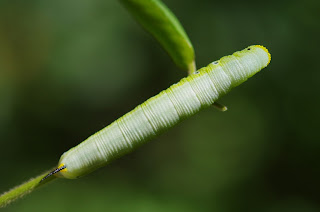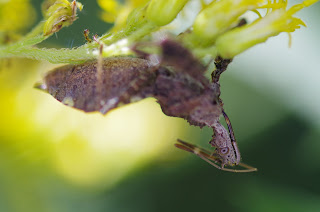I also know what sphinx moth caterpillars look like, more or less, and that is how I knew how to look up today's Backyard Bug of the Day:
This is, I believe, a snowberry clearwing moth caterpillar. The snowberry clearwing moth, which is a kind of sphinx moth. I am not clear on whether this is considered a hummingbird moth. Or a hawkmoth. There is a weird thing about moths in this family that they have all these names. I suppose this is why entomologists use scientific names, but I am not an entomologist, and I wish someone would just clear all of this up. This may also be the caterpillar of the clearwing moth I saw a couple of months ago (meaning the same species - obviously it's not THE caterpillar of that moth, unless time is running backward).
In spite of how it looks, this is not a stinger. This caterpillar is not venomous or toxic. From what I have read, nobody knows what the spikes on the back end of sphinx moth caterpillars are for.
Random Bugs:
Every day now I see one bumblebee and one green sweat bee on the autumn joy sedum. Today I only got a picture of the bumblebee.
This is a fruit fly (not the kind you get in your kitchen - much bigger than that), and Kaufman's Field Guide to Insects of North America says this family of flies is also called peacock flies, because of the patterns on their wings that they use in courtship (although from the pictures in the book, none of them actually look like peacocks, they just have patterned wings). This one is from the genus Eutrea, but the species is not listed in the book. I think its wings look like the night sky.
This is a perspective I have never had on a butterfly before. I could not tell from this vantage point what kind it was, and this is the only vantage point I got, but it appeared to be some kind of hairstreak.
Here's a zoomed-in look.
The opposite view of a butterfly. I've seen them like this before. This one is a hairstreak of some kind.
Here's a pair of cabbage white butterflies doing that aerial dance that they do, fluttering around each other. I don't know if that's a mating thing, or territorial - it could be butterfly violence for all I know, but it is delightful to watch. It looks like they are having fun.
The goldenrod was popular again today, though maybe not quite as busy as the last few days. But today there were swarms of the tiniest gnats over some of the plants:
Obviously they are impossible to photograph, but at least this gives you an idea of the scene.
Except for this wasp, I failed at getting pictures of bees or wasps on the goldenrod today. It was a warm day, and warm days seem to energize them.
I think this might be a wheel bug, which is a kind of assassin bug that has a reportedly excruciatingly painful bite. Which, given that it is a Hemiptera, with a proboscis for mouth parts, would actually be a painful stab. I didn't get a good look at it live, though, and only have pictures like this, so I am not sure if that's what it is.
Yesterday I didn't see any grasshoppers, but today they were back.
Recently I think I posted this as Backyard Bug of the Day - this is the larva of a leaf-mining moth, in its pupal case, which is cut from the leaves it mines. From what I understand, the fact that I found it dangling from a tree means it was looking for a place to attach its case and then pupate.
For now the caterpillar pokes its head out a bit.
Zoomed-in shot. The case is about the size of a sesame seed, to give you some perspective on how small this is.
This is the only sawfly larva left on the dogwood sapling, but it is a different color than the others were, so either this is a later (last?) instar, or a completely different species.
Ladybeetle
After not seeing any spiders for a couple of days, here's one for Arachnid Appreciation:
.
.
.
.
.
.
.
.
.
.
.
.






































No comments:
Post a Comment